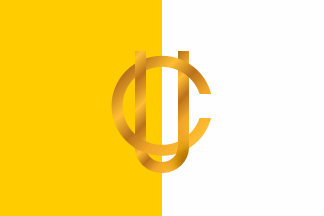
image by Eugene Ipavec, 08 January 2010

Last modified: 2015-01-23 by zoltán horváth
Keywords: universidad peruana cayetano heredia | coat of arms (snake) | snake | ch | spiritus uni vult spirat |
Links: FOTW homepage |
search |
disclaimer and copyright |
write us |
mirrors

image by Eugene Ipavec, 08 January 2010
See
http://americaninlima.com/2009/07/24/politicians-crisis-water-peru/ for a
UFE, at least to me: a horizontal yellow/white flag with a golden interwoven
"UC" monogram. A university?
According to common S. American practices, both flags show the emblems at an
angle, meant for viewing indoors when furled, though I do not usually reproduced
them as such.
Eugene Ipavec, 06 January 2010
This is the flag of "Pontificia Universidad Católica del Perú" (Pontifical
Catholic University of Peru), founded on 24 March 1917 by the French-borne
Reverent Father Jorge Dinthilac, who served as the first Rector of the (then)
"Universidad Católica del Perú". On 30 September 1942, the university was
granted the honorary title of "Pontifical" and the Archbishop of Lima and
Primate of Peru became its Grand Chancellor.
The photo reported by Eugene was taken during the "Adapting to a World without
Glaciers: Realities, Challenges and Action" conference, organized on 7-15 July
2009 at Lima by PUCP and other sponsoring bodies.
The flag of PUCP can be seen on a photo taken during the awarding of the title
of Doctor Honoris Causa to Javier Pérez de Cuellar), shown on p. 10 of the
official book
of the university.
The PUCP photo albums contain several sightings of the flag, for instance:
- Graduation ceremony, 25
July 2008
- First Peruvian Congress
of Analytical Philosophy, 23-25 June 2008
- Fourth Symposium of
Students in Philosophy, 11-14 December 2008
Ivan Sache, 06 January 2010
A Catholic university was my first guess too, given the Vatican colors.
Eugene Ipavec, 08 January 2010
"Asociación de Egresados y Graduados PUCP" (AEG-PUCP), the association of the
ex-alumni and graduates from PUCP, was founded in 1989.
Source: AEG-PUCP website
The flag of AEG-PUCP, as seen on photos taken during the 11th Ceremony to th
Distinguished ex-Alumni (table and full-size flags), held at PUCP on 4 November
2008, is white white a golden fringe and the emblem of AEG-PUCP in the middle.
The emblem of AEG-PUCP is made of a blue seven-pointed comet placed vertically
and surrounded by two yellow half-ellipses, the whole surrounding by the name of
the association in black capital letters. There seems to be somehting written in
smaller letters below the emblem.
- PUCP image gallery,
individual photos:
http://fotos.pucp.edu.pe/fotos/ver/14323/660/0
http://fotos.pucp.edu.pe/fotos/ver/14324/660/0
http://fotos.pucp.edu.pe/fotos/ver/14325/660/0
http://fotos.pucp.edu.pe/fotos/ver/14326/660/0
Ivan Sache, 09 January 2010
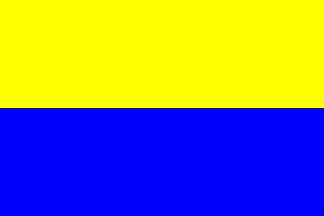
image by Ivan Sache, 06 November 2010
Colegio Inmaculado High School de Barranco was founded on 8 December 1995 by
Dr. Abraham Cuadros Valdivia.
The flag of the institute is shown on the institute's blog maintained by Rafael
Iriarte Torres as horizontally divided yellow-blue .
Source:
http://rafaeliriartetorres.blogspot.com/2009/12/simbolos-del-colegio-inmaculado-high.html
A video
footage of the patriotic parade held on 14 June 2009 confirms the flag (best
viewed at 1:48).
Ivan Sache, 06 November 2010

image by Ivan Sache, 13 July 2014
Colegio José Gálvez was established on 10 November 1936 in Cajabamba (Cajamarca
Department). Classes started on 2 June 1943 in a house rented from Gustavo Ramal
Llave and eventually acquired in 1947. New buildings were inaugurated in 1985.
The institute is named for the lawyer, professor and liberal politician José
Gabriel Gálvez Egúsquiza (1819-1868). Appointed Secretary of War and Navy in
1865, Gálvez was killed on 2 May 1866 during the attack of Callao by a Spanish
fleet, becoming a hero of the South American independence.
The flag of the institute is vertically divided red-blue. Every year, "andinists"
(mountain climbers) from Colegio José Gálvez (ex-alumni, teachers and
parents) celebrate the anniversary of "andinism" (initiated in 1954) on the top
of Mt. Chochoconday, which dominates the town of Cajabamba. They hoist the
national flag and the institute's flag and sing the institute's anthem.
Sources:
http://www.cajamarca-sucesos.com/2014/articulos_de_opinion_2014/siempre_la_j.htm
- Cajamarca Sucesos, 4 June 2014
http://www.panoramio.com/photo/72775799 - Photo, 2012
http://www.panoramio.com/photo/53012246 - Photo, 2012
http://www.asiescajabamba.net/2012/01/andinismo-josegalvista-fotos.html -
Asi es Cajabamba, 18 January 2012
http://www.asiescajabamba.net/2008/12/parada-de-bandera-en-el-cerro.html -
Asi es Cajabamba, 10 December 2008
Ivan Sache, 13 July 2014
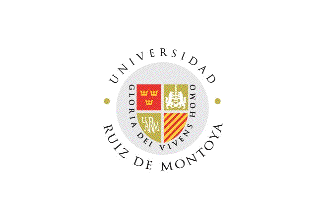
image by Ivan Sache, 13 July 2014
Universidad Antonio Ruiz de Montoya (UARM), based at Lima, is the follower of
Jesuit colleges that emerged in Peru in the 16th-18th centuries. Founded in the
20th century, the "Instituto de Humanidades Clásicas" (Institute of Classical
Humanities) was reestablished in 1991 as the "Escuela de Pedagogía, Filosofía y
Letras Antonio Ruiz de Montoya" (College of Pedagogy, Philosophy and Literature
Antonio Ruiz de Montoya, eventually renamed UARM in 2003.
UARM is named for Antonio Ruiz de Montoya, a Lima-borne Jesuit father
(1582-1652). Montoya founded several Jesuit missions ("reductions") in Guayra,
ruling 39 of them when appointed head of the missions in 1620. In 1631, he
organized the transport of 15,000 Christian Indians, threatened by the Brazilian
slave hunters,to the safer missions located in Paraguay. Montoya obtained in
1637 from King Philip IV of Spain several privileges and measures of protection
for the Paraguyan missions.
Montoya also wrote seminal books on the Guaraní language and a noted history of
the Paraguay missions.
The flag of UARM is white with the seal-like emblem of the university in the
middle.
The emblem of UARM is made of the university's arms, placed on a grey disk and
surrounding by the black writing "UNIVERSIDAD" (top) / "RUIZ DE MONTOYA"
(bottom). The arms of UARM are "Quarterly, 1. Gules three crowns or placed two
and one, 2. Vert a cauldron flanked by two wolves argent, 3. Vert a monogram
"UARM" argent, 4. Gules five bends or. The shield surrounded by the motto
"GLORIA DEI VIVENS HOMO" in letters sable."
Source: UARM website
The sinister part of the arms is related to Ignatius de Loyola, see
Unidad Educadiva San Felipe Neri for more
details.
Photos of the flag are shown:
- on the UARM website,
President's introduction
- on the PUCP photo gallery, 5th Joint Symposium of Students in Philosophy,
20-23 October 2009 -
Album -
Photo
Ivan Sache, 09 January 2010
"Gloria dei vivens hiomo" (Irenaeus, Adversus Haereses [Against Heresies] IV,
20, 7) translates as "The glory of God is a living ma," Irenaeus' aphorism has
been the subject of several interpretations. In his "Letter to priests for Holy
Thursday, March 17, 1996", Pope John Paul II wrote:
"6. Gloria Dei vivens homo. These words of Saint Irenaeus profoundly link the
glory of God and man's self-realization. "Not to us, O Lord, not to us but to
your name give glory" (Ps 115.1 j: repeating often these words of the Psalmist,
we come to understand that "realizing' ourselves in life has a point of
reference and an end which are transcendent, both of them included in the
concept of the "glory of God": we are called to make our life an officium
laudis".
St. Ireneaus (d. c. 202), Bishop of Lyon, is an early church father. "Against
Heresies" was mostly targeted to the Gnosticis, who relied on a secrete, oral
tradition, as opposed to the canonical, scriptural tradition controlled by the
episcopate.
Ivan Sache, 09 January 2010
There is a picture where full UARM flag is depicted, not only its part:
http://www.utec.edu.pe/noticias-firma-convenio-utec-uarm.html
Zoltan Horvath, 11 April 2012
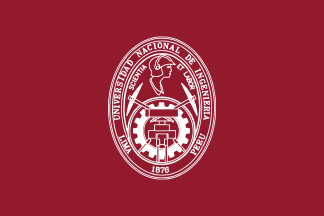
image by Zoltan Horvath, 03 January 2015
"Universidad Nacional de Ingeniería del Perú" (UNI, Peru National University
of Engineering) is the main center of education of engineers, architects and
scientists in Peru. UNI is formed of the Faculties of Architecture, Urbanism and
Art; Sciences; Environmental Engineering; Civil Engineering; Economical
Engineering, Statistics and Social Sciences; Electric and Electronic Engineering;
Geological, Mining and Metallurgical Engineering; Industry and Systems
Engineering; Mechanic Engineering; Petrol and Petrochemistry Engineering; and
Chemistry and Textile Engineering. UNI was established in 1955, succeeding "Escuela
Especial de Construcciones Civiles y de Minas del Perú" (Peru special School of
Civil Construction and Mines), which had been established in 1876 by the Polish
engineer Eduardo de Habich.
Source: http://www.uni.edu.pe/ - UNI
website
Eduardo de Habich (1835-1909) was born Edward Jan Habich from a family of German
origin. He studied at the St. Petersburg Artillery College, fought in the
Crimean War and contributed to the building of the Kiev arsenal. Habich
graduated at the Paris "École Nationale des Ponts et Chaussées" (today, "École
des Ponts ParisTech"), the world's oldest civil engineering school (est. 1747).
Back to Poland, he fought in the 1863 uprising, leading a battalion with his
brother Gustaw. After the Russian victory, Edward went back to Paris where he
served until 1868 as the director of the Polish Superior School established by
Polish emigrants. Hired in 1869 by the Peruvian government, Habich revamped the
La Oroya railways and was member of the commission that revised the statutes of
the Corps of Engineers. President Manuel Prado commissioned him in 1870 to
organise a new school of engineering; Habich brought back from Europe several
emigrated Polish engineers (Folkierski, Babiński, Kluger, Wakulski) and
established in 1876 the forerunner of UNI. Habich founded the Peruvian
Geographical Society and presided the Peruvian Association of Engineers. He
founded the scientific review "Anales de construcciones civiles y de minas del
Perú"
Source:
http://isabelsabogal.blogspot.fr/2013/11/semblanza-de-eduardo-de-habich.html
- "Semblanza de Eduardo de Habich", by Isabel Sabogal Dunin-Borkowski, "Dom
Polski", No. 27, July 2008
The flag of UNI is dark red with the emblem of the university, countercoloured,
in the middle.
Photo:
http://e-huacho.blogspot.fr/2009/02/se-va.html
Ivan Sache, 03 January 2015
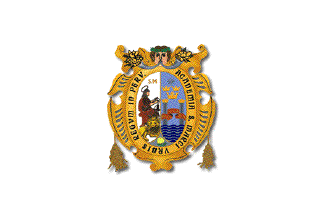
image by Ivan Sache, 31 July 2011
"Universidad Nacional Mayor de San Marcos" (UNMSM) is the oldest
university in the Americas ("Decana de América"), originating in
"Universidad de Lima", founded on 12 May 1551 by Letters Patented
signed in Valladolid by King of Spain Charles V. Inaugurated on 2
January 1553, it started with the two Faculties of Theology and Arts;
three more Faculties were subsequently created: Law (1571), Canon Law
(1571), and Medicine (1634). The University was renamed "Universidad
de San Marcos" in 1574.
In the 19th-20th centuries, several new Faculties were created, most
of them being short-lived and merged together to form bigger entities;
in 1969, only the three Faculties of Literature and Humanities, Law,
and Medicine remained. The creation of 17 new faculties was approved,
in 1983, their number being 20 today.
Among the alumni of UNMSM are the three most famous Peruvian writers,
the poet César Vallejo (1892-1938), the novelist Alfredo Bryce
Echenique (b. 1939) and the novelist Mario Varga Llosa (b. 1936, Nobel
Prize in Literature 2010).
Source: http://www.unmsm.edu.pe/ - Official website
The flag of UNMSM is white with the coat of arms of the University in
the middle.
Source: http://www.unmsm.edu.pe/?url=inicio-simbolos
The flag can be seen on images of the ceremony of flag hoisting at the
Faculty of Odontology, together with the flag of Peru and the flag of
the Odontology Faculty (see below)
https://picasaweb.google.com/109706742705761720188/IZAMIENTODEBANDERA21JULIO2011 - Picasa album, 21 July 2011
The coat of arms of UNMSM is made of an oval shield divided per pale
and grafted in base. The three fields are outlined in gold.
The first quarter shows on a white background Evangelist St. Mark clad
with a brown tunic and a red cloak, sitting and writing, with a foot
on a yellow lion. Above the saint are the golden initials "S.M." [San
Marcos].
The second quarter shows on a sky blue background in base the blue
waves of the ocean from which emerge two silver columns each with a
golden capital, in Corinthian style, tied by a red scroll charged with
"PLUS ULTRA" in golden letters. Above the columns are three golden
crowns ensigned with a yellow radiant sun shaped like a windrose.
The base of the shield shows on a sky blue background a yellow lime
fruit with a green stem and small green leaves.The shield is surrounded by a golden ring charged with the Latin
writing "ACADEMIA S. MARCI VRBIS REGVM IN PERV" [St. Mark Academy of
the Royal Town in Peru] in black letters.
The whole is surrounded by an elaborate orle, from which hang two
golden tassels shaped like grapes.
The shield is surmounted with the face of a cherub and a laurel
wreath. From the cherub's mouth emerge two silver cornucopias, one of
each side, filled with products of the soil and laurel branches.
This coat of arms was adopted in 1574, replacing an older coat of arms
quite similar in design.
The early coat of arms of the University shows dexter the Virgin of
the Rosary, the patron saint of the Dominican Fathers, sinister a sun
over the waves of the ocean, and in base a lime fruit. The 1578
"Constitutions" say: "in base is a design based on the Royal arms with
the pomegranate, replaced here with a lime". The arms are canting, a
lime being in Spanish "lima" [but the name of the town comes from a
local word and has nothing to do with lime]. The shield is described
as crowned with the "laureled face" of an angel or cherub, mentioned
in all subsequent "Constitutions", including the "Consolidated
Constitutions" released in 1624 in Madrid.
A sealed document dated 1604 shows St. Mark and the two columns but
lacks the "laureled face". The shield is represented with lateral
ornaments on an engraving by Juan de Noort shown on the frontispiece
of Pedro J. Bermúdez de la Torre's "Oración informativa", published in
1699. The coat of arms is also engraved in stone in the chapel of the
Virgin of Antigua, where the graduation ceremonies take place, and in
the cathedral of Lima, as decided in 1795 by Director of the
University, C. Montaño.
Source: http://www.unmsm.edu.pe/?url=inicio-simbolos
The three crowns and the windrose also appear on the coat of arms of
Lima.
The blog "El Reportero de la Historia" reported in February 2008 a
movement to "create" a flag of UNMSM, called by the blog's author "an
attempt against history and tradition". It also reports the use in a
public ceremony of a "so-called flag", of unknown origin, made of
three vertical stripes, sky blue, white and sky blue with the
University coat of arms in the middle.
The blog reproduces a public letter sent on 30 January 2008, to the
Director of the University by three Professors, Miguel Maticorena
Estrada (founder of the Department of History of the University in
1993), Vicente Ugarte del Pino (former President of the Supreme Court
of Peru) and Rafael Jaeger Requejo (Professor at the Faculty of Law).
The authors of the letter explain why there is no need to create a new
flag.
The "flag" ("bandera") used by the university is indeed its
"standard" ("estandarte"), more than four-centuries old. The word
"bandera" does not appear either in ancient documents or in the
"Constitutions" of the University. "Constitutions" 224, from 1581,
prescribe that the doctoral students shall raise "the standard
('estandarte') of the University with the Royal arms on one part and
the arms of the student on the other part, painted on taffeta".
Diego de León Pinelo mentions in a book dated 1648 the "University
flag" ("bandera'), which must indeed have been the standard.
Resolution No. 10,288 signed on 10 September 1951 by Director Dr. Pedro Dulante commissioned Dr. Jiménez Borja, Dean of the Faculty of
Literature, to design "a new flag" ("bandera"), to be used in the next
University Olympics. It was proposed to replace the "less visible and
anaesthetic old flag" with a new institutional flag described as
follows: "A white rectangle charged with the coat of arms of the
University surmounted with 10 stars, each of a different colour and
representing one of the 10 Faculties composing the university". The
colors of the faculties are:
- Law: Green
- Medicine: Purple
- Literature: Pink
- Sciences: Sky blue
- Economic Sciences: Red
- Pharmacy and Biochemistry: Blue
- Odontology: Lilacs (see below, 5.)
- Education: Cedar
- Chemistry: Yellow
- Veterinary Medicine: Red currant (see below).
The proposal was rejected by Dr. Luís A. Eguiguren and the Commission
in charge of writing the history of the University.
The authors of the letter conclude that there is no need to create a
new symbol for the University, arguing that the four-centuries old
standard simply needs to be promoted as the institutional flag of the
University.
Source:
http://www.reporterodelahistoria.com/2008/02/una-bandera-para-san-marcos.html
Oddly enough, the rejected flag proposal seems to have been
manufactured. It can be seen on photos taken on 10 June 2011 during
the graduation ceremony at the Faculty of Veterinary Sciences (see
below)
Source:
http://veterinaria.unmsm.edu.pe/foto_graduacion_LXXIII_2011/index.html (Photo No. 4)
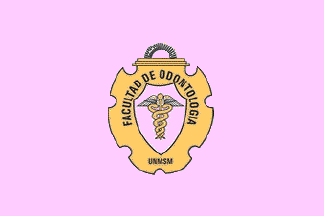
image by Ivan Sache, 31 July 2011
The teaching of Odontology officially started in Peru on 23 July 1868
with the creation of the Odontology Section of the San Fernando
University, transformed in 1920 in the Odontology Institute, itself
replaced in 1931 by the Odontology School. The Odontology Faculty was
eventually created on 29 October 1943 by Law No. 98,938.
Source: http://odontologia-unmsm.edu.pe/ - Official website
The flag of the Odontology Faculty is lilac (the Faculty color, see
above) with the coat of arms of the Faculty in the middle.
It can be seen on images of the ceremony of flag hoisting at the
Faculty of Odontology, together with the flag of Peru and the flag of
the University.
The emblem of the Faculty shows on a lilac background a caduceus (with
brown staff and snakes and white wings), the whole surrounded by a
brown elaborate orle charged with the black writings "FACULDAD DE
ODONTOLOGIA" and "UNMSM".
Source:
https://picasaweb.google.com/109706742705761720188/IZAMIENTODEBANDERA21JULIO2011 - Picasa album, 21 July 2011
The Veterinary Medicine Faculty was founded in 1946
Source: http://veterinaria.unmsm.edu.pe/index.htm - Official website
The flag of the Veterinary Medicine Faculty is red currant (the
Faculty color, see above, 4.) with the seal of the Faculty in the
middle.
It can be seen on images of the celebration of the 65th anniversary of
the Faculty.
The emblem of the Faculty is a white disk charged with a green Rod of
Asclepius itself charged with a red "V", thus forming a kind of rebus
for "Veterinary Medicine". The disk is surrounded by a yellow ring
charged with the red writings "FACULDAD DE MEDICINA VETERINARIA" and
"UNMSM".
Source: http://veterinaria.unmsm.edu.pe/foto_lunes_4_2011/index.html (Photo
No. 14)
Ivan Sache, 31 July 2011
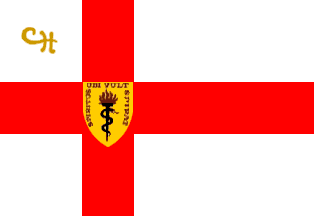
Flag of Universidad Peruana Cayetano Heredia is
here.
Valentin Poposki, 01 Dec 2005
White flag with red cross throughout offset to the hoist (approx. specs:
(8+5+8):(8+5+18); Danish style), golden "CH"
script monogram on the upper hoist, and ogival shield on the cross core: Or
a serpent Vert coiled on a torch Sable flaming Gules and in orle the Latin
sentence «spiritus uni vult spirat» Gules.
António Martins, 23 Feb 2008
Universidad Peruana Cayetano Heredia (UPCH) was founded in 1961 by famous
Professors of Medicine from the Faculty of Medicine San Fernando of the National
University of San Marcos rejecting the state control imposed by the government
on the universities. The main founding fathers were the psychiatrist Honorio
Delgado (1892-1969; Director in 1962-1967) and the specialist of altitude
medicine Alberto Hurtado (1901-1983; Director in 1967-1969). The university is
named for the physician and politician Cayetano Heredia (1797-1861), first Dean
of the Faculty of Medicine of the University de Lima, founded on 6 October 1856
upon his request. The university is made today of eight faculties and three
institutes, altogether catering some 2,000 students.
The shield includes a flaming representation of the Rod of Asclepius, the
symbol of medicine. The Latin motto "Spiritus ubi vult spirat" (Gospel of John
3:8) means "The spirit blows where it wills"
The flag was selected on 6 December 1967 by a jury made of Director Alberto
Hurtado, Drs. Hernán Torres, Alberto Cazorla, Leopoldo Chiappo, Carlos Vidal and
Mr. Juan Manuel Ugarte Elespuru. The selected design No. 1 was contributed by
Pr. Dr. Manuel Chavarri. Used in the official acts, the flag was once damaged
and quickly forgotten. Subsequently, the flag of the Tuna University was used
when required. Secretary General Juan Jiménez Bendezú noticed that the original
flag had never been officially accepted; the University Council was prepared to
officially adopt a flag but there was no consensus on the original flag. Five
new proposals, contributed by two designers, were evaluated on 27 March 1996 by
the University Council, that eventually adopted the 1967 design.
Ivan Sache, 18 November 2010